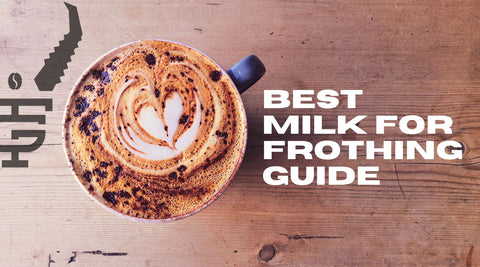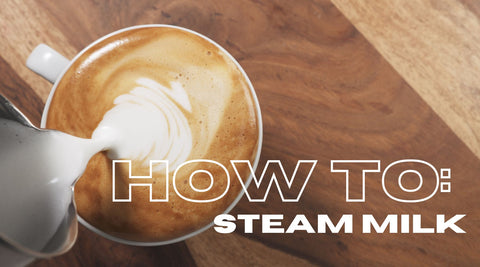Have you ever pondered which type of higher fat milk is ideal for creating that great milky coffee and creamy foam for your latte artwork?
We will take you through the world of whole, skim, and semi-skim dairy and almond milk brands as well as oat, almond, coconut milk and soy milk and whole milk substitutes and alternatives, all in search of the best milk for frothing and creamy texture.
Equipped with this knowledge, you'll be ready to create the perfect froth for your next latte masterpiece!
Best Milk For Frothing Snapshot
-
Discover the best way for frothing milk for your lattes, from dairy to non-dairy options like coconut milk.
-
Equip yourself with essential tools and techniques.
-
Ensure optimal temperature while taking into account freshness of milk & avoiding non-dairy additives for perfect latte arts!
- Some of our favorite options that we use if we don't have a milk frother.
Dairy Milk Options for Frothing

When it comes to cow's milk, there are three primary contenders: whole, skim, and semi milk.
Each of these options has its advantages and challenges in the 'milk for frothing' process. In the following subsections, we will delve deeper into the properties of each type of dairy milk, helping you understand which is best suited for your frothy creations.
From the rich and creamy foam of whole cow's milk to the firmer, more stable foam of skim milk, the right dairy milk can make all the difference in your quest for perfect latte creations. Let's dive into the world of best milk options, starting with the ever-popular whole milk.
Whole Milk
Whole milk is the gold standard when it comes to frothing, thanks to its perfect balance of fats, proteins, sugar, and water. The high-protein content of whole milk creates the lushest foam, offering a luxurious texture for your latte or cappuccino.
However, it's essential to ensure the freshness of the milk you're using, as higher fat and protein levels may be affected by excessive glycerol, making it more challenging to form a stable foam.
As you whisk the milk or use a milk frother, whole milk's unique composition will create air bubbles that result in a creamy, stable flavor that's perfect for your coffee beverage.
But what if you're looking for a lighter option with fewer calories? In that case, skim milk might be the answer.
Skim Milk
Skim milk, with its lower fat content, is perfect for freezing and honing your latte creative skills. The bubbles it creates are thinner and more delicate, making them easier to shape than those created with whole milk. Plus, skim milk forms larger air bubbles and produces a more stable consistency.
This delightfully light and airy foam is a fantastic option for those looking to enjoy a foamy coffee treat without the added calories of whole milk.
However, if you're seeking a middle ground between the richness of whole milk and the lightness of skim milk, let's explore the world of semi-skimmed milk.
Semi-Skimmed Milk
Semi-skim milk, also known as two percent milk, is an interesting option that retains some of distinct flavor of the cream but with significantly less fat than whole milk.
This makes it a great choice for those looking to maintain a healthy lifestyle without sacrificing the frothy goodness of their coffee drinks.
While full cream milk the foam is generally preferred for its creamier froth and delicious taste, semi-skimmed milk can still be used for frothing.
However, it won't yield the same luxuriously creamy froth as whole milk froths or the sturdier consistency of skimmed foam.
Try all 3 of these milk options to see the difference, plus it's really good practice! Now, let's venture into the realm of the best non-dairy alternatives for frothing.
Non-Dairy Milk for Frothing

For those seeking dairy-free options or simply wanting to experiment with different flavors and textures, we have good news: there are several delicious non-dairy options for frothing!
Oat, almond, soy, macadamia milk, and coconut milk are all fantastic options that can cater to various dietary preferences and still provide the frothy experience you crave.
Among these non-dairy choices, oat milk stands out as the best option for frothing, thanks to its similarity to whole dairy milk in its makeup and heating requirements.
In our opinion oat milk is the ideal non-dairy substitute for your frothy endeavors.
Oat Milk
Oat milk's remarkable similarity to whole milk milk in terms of makeup using vegetable oil and stabilizers makes it an excellent non-dairy cow's milk alternative for frothing.
The heating process of oat milk is quick and comparable to that of cow's milk, making it a great choice for creating a creamy, frothy beverage.
For those seeking a barista-approved oat milk option, the California Farms Barista Blend is an exciting alternative to the popular Oatly Barista Edition, available conveniently on Amazon.
This blend successfully solves the fundamental problem of creating stable oat milk foam, ensuring that your non-dairy latte art is just as impressive as its dairy counterpart.
Almond & Coconut Milk
Frothing almond milk is another excellent choice for frothing among non-dairy milk alternatives. For the best thick foam frothing results, consider barista-specific almond milk options such as California's Barista Blend and Pacific Natural Foods Barista Series Almond Blenders.
When it comes to temperature, the ideal range for frothing almond milk is between 130-140 degrees Fahrenheit (54-60 degrees Celsius).
At around 130 degrees Fahrenheit, almond and coconut milk also starts to foam and create the perfect texture for your coffee drink.
Almond and coconut milk's higher fat content compared to other non-dairy milk options and is considered the best non dairy milk for those looking to add some extra nutrition to their diet. Almond milk creates a light, nutty foam, or macadamia milk is another nutty option.
Soy Milk
Froth soy milk serves as the closest milk substitute that's perfect for frothing and creating stunning latte art. When frothed, soy milk creates a luxuriously rich foam that is incredibly stable and will stay put atop your drink for an extended period of time.
With an impressively similar protein content to whole high protein milk, soy milk's delicious foam is sure to impress.
With this comprehensive understanding of the best non dairy milk and the best non dairy milk part-dairy milk options, let's explore the coffee shops essential techniques and tools for achieving the perfect milk froth.
Essential Techniques and Tools for Perfect Milk Froth
Creating the perfect milk froth is an art that requires the right tools and techniques.
From milk frothing machines to electric whisks, French presses, and shaker bottles, there are a wide array of options to help you achieve that velvety, creamy foam.
In addition to the tools, maintaining the optimal temperature between 140-150F is crucial for a stable and delicious skim milk froth too.
In the following subsections, we will delve into different milk frother options and discuss the ideal temperature for frothing various types of milk. With these tools and techniques at hand, you'll be well-equipped to create the perfect milk froth for your coffee creations.
Milk Frother Options
Supplement coffee equipment can offer a unique advantages for creating the perfect frothy frothed milk. For example, a frother machine like the Secura Frother can create a variety of delightful textures of frothed milk.
If you prefer a more hands-on approach, an electric frother is an effortless option for frothing milk.
Alternatively, a French press or shaker bottle can be used to create the perfect froth for your milk, offering a simple and cost-effective solution. With these options in mind, let's discuss the optimal temperature for frothing different types of milk.
Optimal Temperature for Frothing
Achieving the right temperature when frothing milk is essential to avoid unpleasant flavors and to guarantee that the proteins do not denature, resulting in a more stable consistency.
When milk is steamed at a temperature of 100° C or more, an interesting transformation known as “browning” occurs, causing a loss of nutritional value and a yellowish or brown color.
The ideal temperature for milk froths lies between 140-150F, ensuring the perfect texture and taste for your coffee. With these techniques and tools in mind, you're now equipped to tackle common frothing challenges and solutions, ensuring the perfect milk froth every time.
Common Frothing Challenges and Solutions
Creating the perfect milk froth is not without its challenges. Ensuring the freshness of milk and avoiding non-dairy milk additives that can affect foam stability are key aspects to consider when frothing.
These challenges, if not addressed, can impact the quality of your frothy coffee drinks.
In the following subsections, we will discuss the importance of milk freshness and how to avoid non-dairy milk additives that can disrupt the balance of milk protein and fat content, making it more challenging for frothing plant-based milk.
Freshness of Milk
To ensure a delightful froth with fresh dairy, make sure to use milk that is not expired and has been stored properly. With these tips in mind, you'll be able to achieve the perfect froth with fresh milk every time.
Non-Dairy Milk Additives
Non-dairy milk additives, such as sugar, thickeners, and stabilizers, can affect the stability of the foam when using milk for frothing with milk or plant-based milk. It is essential to read labels and be mindful of any additives that may cause digestive discomfort or other health concerns.
By carefully measuring the amount of fat compared to protein in the milk, you can ensure the foam turns out just right.
With this knowledge, you can avoid non-dairy milk additives that can affect coffee foam and stability and enjoy a perfect frothy coffee experience, regardless of your choice of milk.
Froth Them All
Choosing the best milk for frothing is essential for achieving the perfect latte art and a delicious coffee experience.
From the creamy, thick whole milk foam to the lighter, thin froth of skim steamed milk. The richness and variety of non-dairy milk alternatives shows there's an option for everyone.
By mastering the essential techniques and tools to create a delightful, velvety warm milk foam to elevate your coffee experience to new heights.
So, go ahead and experiment with frothing warm milk and find your perfect frothy coffee companion!
Frequently Asked Questions
What is the best milk for frothing or milk froths?
Whole milk which contains whey protein is the best type of milk for frothing. This high protein milk has a higher fat content that helps to produce a thick and foam.
Plus, it offers a richer flavor compared to other milks like skim, almond milk, or coconut milk which can create lighter, fluffier foam.
For the best results, make sure to froth your milk immediately before drinking.
What milk is best for latte foam?
For the perfect latte foam, look no further than whole dairy. It contains the ideal balance of proteins, fats, sugar, and water to create smooth, silky microfoam.
You won't be disappointed!
What milk is best for steaming and foaming?
If you want to get the best results from rice milk when steaming and foaming, whole or 2% rice milk are your best options! The higher fat content of these milks will produce a smoother and creamier texture than skim rice milk.
If you're looking for a non-dairy alternative, soy, or almond milk, or oat milk are great alternatives. Enjoy your delicious latte!
Does 2% milk froth better?
While whole milk is usually the best option for creating a creamy, thick foam, you can definitely use 2% milk when making your favorite frothy beverages! As long as it's fresh and kept cold, you should be able to achieve a great result.
With a bit of practice, you should be able to produce delicious foams with full cream both whole and 2% milk.
How to steam milk?
Steaming milk (or hot milk froth) is an art, not a science. Start by heating the steam wand and then insert it into the milk jug just below the surface of the milk about 12 inches from the side. Move it slowly and watch as the milk expands.
Allow it to stay in the steam for 5-10 seconds before you remove it.
Mastering a thick and creamy foam takes practice, but it’s definitely worth the effort.



